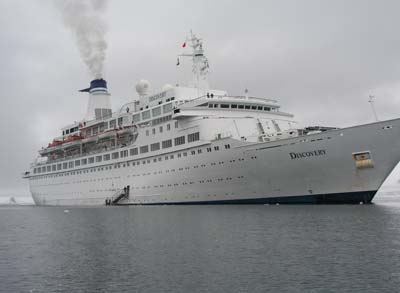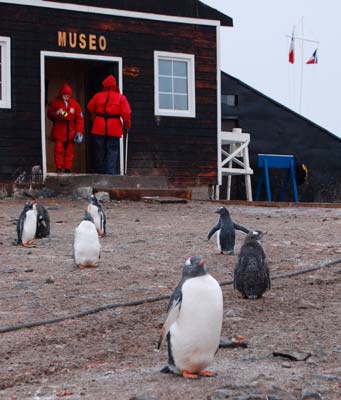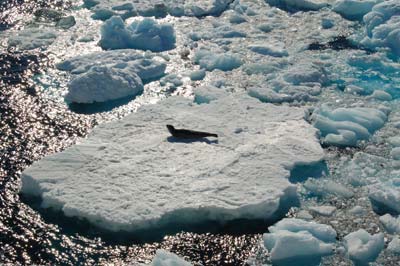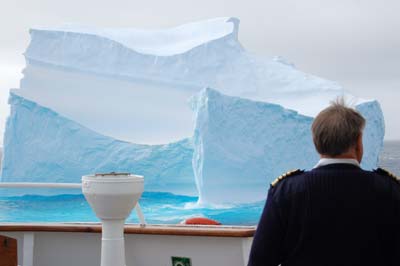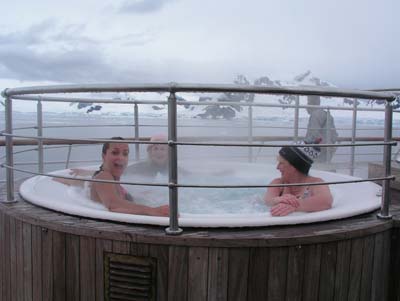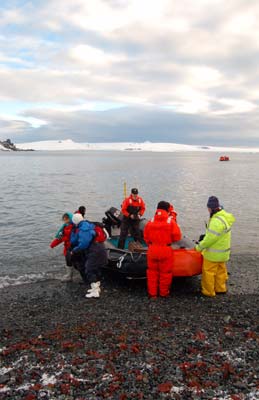Antarctica — unimaginable beauty
by Debi Shank, ITN
After a full day at sea, I woke up, peered through the window of my cabin and had my first sighting of Antarctica. The months of anticipation were over as we sailed past Deception Island and began our 5-day voyage through the South Shetland Islands and down the Antarctic Peninsula.
The first distinct sound I heard when the ship stopped was ice crackling as it floated by the ship, as though someone were pouring a very large drink. The first smell — penguin guano, wafting through the air from about a quarter mile away.
Beginning the voyage
No matter how you slice it, Antarctica is a distant destination. Many passengers aboard our ship were from England and Europe, with some from Australia and a few from Japan. I suppose, coming from North America, my husband, John, and I had it easy. We flew from San Francisco, California, to Buenos Aires, Argentina, where we spent two nights at the luxurious Sheraton Park Tower. Then we took a 3-hour flight to Tierra del Fuego and its capital, Ushuaia, where we would embark Voyages of Discovery’s mv Discovery.
Before boarding our transfer bus, we dug out the windbreakers and gloves stashed in our carry-on bag, as there was a definite change in climate between the two Argentine cities. Our first night at sea was expected to be rocky, since we would be crossing the dreaded Drake Passage. We were well prepared with Dramamine, which we had started taking the day before in addition to ginger pills. I didn’t want to take any chances after reading tales of previous trips across this notorious waterway. In the public areas, the ship’s crew even had sickness bags displayed like brochures. Fortunately, for John and me, all our preparations were in vain, as we enjoyed a smooth crossing, the ship gently lulling us to sleep. Other passengers weren’t quite as seaworthy.
Preparing to step ashore
Our first full day at sea gave me a chance to get my sea legs and my bearings by exploring the ship. It also was the first opportunity of many to learn about the unique and unspoiled environment of Antarctica. One of the onboard naturalists, Dr. Peter Carey, gave a mandatory briefing for all passengers who planned to go ashore. We learned how to prepare for excursions, how transfers were handled and about restrictions while on the continent.
Passengers were assigned to groups. Each group was allowed only one hour ashore — a necessity to accommodate all 500 passengers. We were instructed about the minimum distance (15 feet) to maintain from penguins and seals. The penguins, however, did not have that same restriction and could approach us at will.
There were five naturalists on board — some of whom had dedicated years to studying their particular fields in Antarctica — and all were available after lectures and during the cruise for questions. Presentations about the fragile ecosystem, penguins, seabirds, seals, whales and early Antarctic expeditions were offered in the Carousel Lounge and, if it was too crowded (as it often was), on closed-circuit TV in each cabin. These lectures also were replayed on TV throughout the day. Twenty-two hours after setting sail, we crossed the Antarctic Convergence, signifying our official entrance into Antarctic waters. The convergence is marked by a sudden decline in water temperature, from three to five degrees Fahrenheit, and there is also a change in the water’s density and salinity.
As we continued toward our destination, I found every opportunity to be on deck, decked out in my flashy, oversized, bright-red parka, courtesy of Voyages of Discovery.
It was necessary to bundle up while we were at sea — thermal underwear, gloves, hat, scarf and parka. If any part of me was exposed, it soon felt frozen. And I wasn’t the only one; there was a sea of red parkas on the top deck, everyone jockeying for position at the ship’s rail and scanning the horizon for penguins, seals and whales as we plied the Southern Ocean.
Excursions
On our cruise, there were six groups for each excursion, their order rotated on subsequent days so no group was always last. Our first scheduled stop was to be Deception Island, but, as with all things related to Antarctica, excursions are subject to weather, ice conditions and the whim of the captain. The excursion was canceled because a ship ran aground two weeks prior and the incident was still under investigation.
Plan B was a glacier walk, but that, too, was negated by ice, so we went with Plan C, a Zodiac cruise along a nearby glacier. The conditions were too rough to make a landing, but we were able to get close to the rocky shore where gentoo penguins were scattered about and a lone fur seal stood sentry.
As we cruised around the bay, snapping photos left and right, the sound of squawking penguins and the Zodiac’s engine was broken by a thunderous boom. A piece of the glacier had calved around the bend just out of our sight. We stayed with the penguins, awed by their cuteness but repulsed by the odor, until it was time to head back to the ship, now barely discernible through the fog. Assisted by crew members out of the Zodiacs, we climbed up the gangway to the lobby, where we doffed our life vests and, for future excursions, our boots, which were placed in plastic bags so we could take them to our cabin for a more thorough cleaning.
Dining options
After an exciting first excursion, we readied ourselves for dinner in the Seven Continents Restaurant on the Coral Deck. Two seatings were available (6:30 and 8:30). Each 4-course meal offered selections of soup, salad, main course and dessert. A vegetarian menu also was available.
The wait staff was charming, courteous and meticulous, serving each course promptly. Although we were assigned to the early seating, I never felt rushed to finish. The Lido Buffet was our choice of dining venue for breakfast and lunch, but these meals also could be eaten in the restaurant. Breakfast was standard fare. Lunch varied on a daily basis and was occasionally themed: Oriental, Italian or French.
There was one alternative choice for dinner, the Yacht Club, which required advance reservations, at no additional charge. A late-night snack was served in the Palm Court at 11:00 and, keeping with British custom, afternoon tea was served at 4.
Iceberg alley
For me, day three started early. We were promised a spectacular show of ice, and I wasn’t disappointed. Sleep could wait; there were icebergs outside and I didn’t want to miss a single one.
With my body thoroughly insulated from the cold, and armed with hand warmers, binoculars and camera, I braved the morning chill and made my way to the top deck. It was exhilarating. Spectacular cathedrals of ice larger than I ever could have imagined surrounded me. And the color! They weren’t just white, like snow, they were dazzling shades of translucent blue — and they were beautiful.
We started the day in Hope Bay and lingered for a short time, taking in the landscape before cruising through the Antarctic Sound and down the peninsula. Passing berg after berg, each one more incredible than the last, my finger left the camera’s shutter only long enough for me to take in another. During our days at sea, Dr. Peter Carey used the ship’s P.A. system to inform passengers when whales, seals or penguins were spotted as well as to educate us on the icebergs we were seeing.
Penguins up close
Days four and five gave us the opportunity to visit two penguin rookeries.
The first was a gentoo rookery at a Chilean base, Gabriel Gonzalez Videla, at Paradise Harbor, which sat under a light dusting of snow and overcast skies. Armed against the elements, our group, the third one out, made its way down the gangway into the Zodiac. I was finally going to step onto Antarctica.
The 10-minute Zodiac ride allowed us the opportunity to photograph the ship in a spectacular setting and cruise amongst smaller icebergs almost close enough to touch. As we approached the landing dock, the guano odor permeated the air, welcoming us to the real Antarctica. Making our way along the concrete pathway covered in mud and penguin droppings, I was grateful for the knee-high rubber boots. (Not that the muck was knee high.) Left, right and directly in front of me, gentoo penguin chicks stood around and called out for their parents. Dirty and still partially dressed in their baby down, these 8-week-old chicks were waiting for their next meal.
Their cumbersome waddling, with wings outstretched, up and over rocks, through the mud and muck and along the pathway was a thrill to watch. As I got down to their level, the more curious approached me for a closer look; others were content to lay sprawled out in the mud in an effort to cool themselves.
The ship’s naturalists were available to answer questions and also served as the Penguin Police, making sure we didn’t venture too close to the penguins or too far from the area.
All too soon my hour ashore was up and I made my way back to the landing area, where crew members equipped with brushes and buckets of water scrubbed the mud off my boots before I climbed back into the Zodiac.
Our second landing opportunity, the following day, was at a chinstrap penguin rookery at Half Moon Island, also home to an Argentine base. Ours was the first group ashore, leaving at 7 a.m., and we were rewarded with pristine conditions. It was a much different experience than that of the previous day — no mud or muck and little odor.
The beach landing here required us to step off the Zodiac into the cold water. This is where the knee-high boots paid off, keeping my feet dry and toasty.
There was no walkway, just a steep incline to reach the main concentration of penguins. They made their nests as high as they could amongst the rocky terrain and out of the snow.
We also were able to observe Antarctic fur seals, Arctic terns and skua gulls, the latter feasting on an unfortunate penguin chick. The weather that morning was spectacular, and the sun glistened off the snow-white cliffs that surrounded us. I didn’t want it to end.
Glorious sunset
From Paradise Harbor, we sailed down the Gerlache Strait toward the Lemaire Channel. The ever-changing landscape of this scenic passage beckoned me to continue shooting in an attempt to “capture” Antarctica.
The big prize, however, was the even more spectacular sunset, which lasted about 45 minutes. The sky turned from blue to shades of orange, ochre, peach, red and yellow. It was so amazing that many crew members brought out their cameras, commenting on the rare sight.
As we sailed on toward the Lemaire Channel, the promise of more incredible scenery waited, but the weather conditions and, in this case, ice dictated our fate. The channel was blocked, preventing our passing through. We were forced to turn around. As a consolation, we were treated to the sight of a feeding minke whale.
Bidding farewell
Day six found us going back across the Drake Passage, leaving behind a continent that I had barely touched. As Antarctica faded from view, whales escorted us into what would be a more tumultuous passage through the Drake as we headed back toward Ushuaia and the Strait of Magellan to Punta Arenas, Chile. I dared to face the Drake head on and, armed with my cold-weather gear and sturdy shoes, ventured up to the forward deck and held on tight as the Discovery pitched and rolled, sea spray being tossed over her bow. It was a fitting end to a spectacular week in Antarctica.
Chilean fjords
We awoke the next morning sailing through the Beagle Channel and up the Strait of Magellan. I was prepared to be disappointed with the scenery, but I was proven wrong. In the fjords, trees and lush greenery adorned the mountainsides. Glaciers, some of them several thousand feet long and hundreds of feet thick, cascaded to the water’s edge. On higher cliffs, waterfalls gushed from invisible lakes, tumbling down to the sea.
The shoreline revealed nesting cormorants and lazy seals, almost invisible to the naked eye but easily viewed with binoculars. The highlight of this portion of Patagonia was the Garibaldi Glacier, a mass of ice so large that it made a large yacht anchored in its shadow appear like a toy boat. We awoke on day eight in Punta Arenas, the end of the journey, for us. Other passengers would continue on for another week through more fjords to Puerto Montt, ending in Valparaiso, Chile.
After a 2-hour city tour, we made our way to the airport and began our long journey home.
Aboard ship
All cabins on the mv Discovery are outside. Ours, on the Promenade Deck, was small but adequate and included two windows, two twin beds (unable to be joined), a desk, two chairs and a small table.
The TV was inside a cabinet that contained a small refrigerator and a few drawers. The three fl oor-to-ceiling closets had plenty of room to hang all our things, and there was room under the beds for luggage. Our bathroom had a full tub with shower, plenty of counter space and shelves to place all our toiletries. With the constant movement of the ship, it was imperative that everything be securely stowed; a few times things ended up on the fl oor. My only complaint about the cabin was the key system. It was necessary to carry our room key — an actual key — and our ship identification card with us at all times. The I.D. card was linked to our shipboard account for purchases; it also was used whenever we left the ship or returned.
I was constantly misplacing my I.D. card and wondering what pocket I had put my key in. I saw several savvy passengers each with a lanyard around their neck holding a punched I.D. card and their room key.
The ship’s Internet café offered four computers for passengers’ use, and wireless access was available in two locations where I was able to use my laptop. I could download my photos each day and send e-mails home while watching the passing scenery through the panoramic windows. Internet rates were 10¢ per minute and blocks of time could be purchased in advance.
An onboard highlight, for me, were the art classes with artist and sculptor Scott Hanson. Specializing in marine and bird life, his beautiful bronze sculptures were on display in the gallery on the Riviera Deck. Scott’s classes, however, used a much simpler medium, polymer clay. With classes limited to 45 participants each day, Scott demonstrated and taught us how to mold the clay to make our own penguin, fish or turtle pins. When our pins were finished, he collected our pieces so they could be baked in the kiln he had brought on board. We picked them up later.
Before you go
I had completely overpacked, preparing for the most frigid conditions. Not knowing what the weather would be like made it hard to prepare, but there were certainly some things I could have left at home.
I know I went overboard when it came to foot protection: rubber boots, boot liners, sock liners and wool socks. The boot liners, while comfy, weren’t really necessary. As for the socks, one pair of each would have been sufficient. I wore them only for about two hours a day, so they could have been used on multiple days.
To save space on the way home, passengers may leave their boots behind, giving future passengers who don’t pack proper boots the opportunity to borrow them.
It was important for me to have my ears covered, in addition to my neck and chin. A muffler was less bulky than a scarf and stayed in place better over my nose without leaving gaps like the scarf did.
Again, I overdid it with the gloves, opting for thick, waterproof gloves, pairing them with thin glove liners. Most days, while on deck I wore the glove liners and my regular Polartec® gloves. On excursions, the thick gloves were too cumbersome and bulky to handle cameras and zippers, and it was too warm for them anyway.
Between the wind and the sun, eye covering was important. Although I splurged in this area, it was money well spent. I purchased a pair of glacier glasses with side shields; they kept the wind out of my eyes while I was out on deck.
I’m glad I packed a small, 3-outlet power strip to keep my batteries charged and my laptop plugged in. There was only one 110V outlet in each cabin; in our case, it was behind the TV cabinet, but other cabins had more accessible 110V outlets. We also had two 220V outlets, but I couldn’t use my voltage converter because they were recessed into the wall.
Speaking of batteries, I found that my rechargeable AA batteries wore out a lot faster (hours) in the colder temperatures than the lithium batteries, which lasted much longer (days). I never experienced the total shutdown of either camera due to extreme cold, but I did my best to keep them inside my parka or camera bag.
I suggest you take a few dollars ashore with you. At the Chilean base, we purchased a souvenir certificate for $3; at the Argentine base, I purchased a lapel pin for $5.
Overall, our adventure exceeded my expectations. Movies and documentaries didn’t prepare me for the experience of Antarctica. Although I was disappointed with the limited amount of time we actually had ashore — I could have lingered for hours among the penguins — I will always cherish my journey to the White Continent. ITN
Debi and John Shank were guests of Voyages of Discovery; John’s airfare, $1,725, was not included.
PLANNING AN ANTARCTIC VISIT
Our February ’07 “Antarctica & Chilean Fjords” cruise with Voyages of Discovery, formerly Discovery World Cruises (1800 SE 10th Ave., Ste. 205, Ft. Lauderdale, FL 33316; 866/623-2689, www.voyagesofdiscovery.com), was the last Antarctic sailing of 2006-2007. There is a selection of sailings scheduled for the 2007-2008 season.
The price of the full 20-night “Antarctica & Chilean Fjords” voyage begins at $4,995 per person with early-booking discount. When is the best time to go? By the time of our late-season cruise, the penguin chicks were almost ready to venture off on their own. The adults’ mating season begins in November, and by December they have prepared their nests, with the chicks hatching sometime in January.
Weather is also a consideration. While daytime temperatures hovered in the mid-40s, the wind chill during transit lowered the temperature considerably. On our cruise, we were fortunate to have clear, blue skies and fairly calm seas, but you can’t bank on that so it’s best to be prepared — or overprepared — for whatever nature may dish out.




